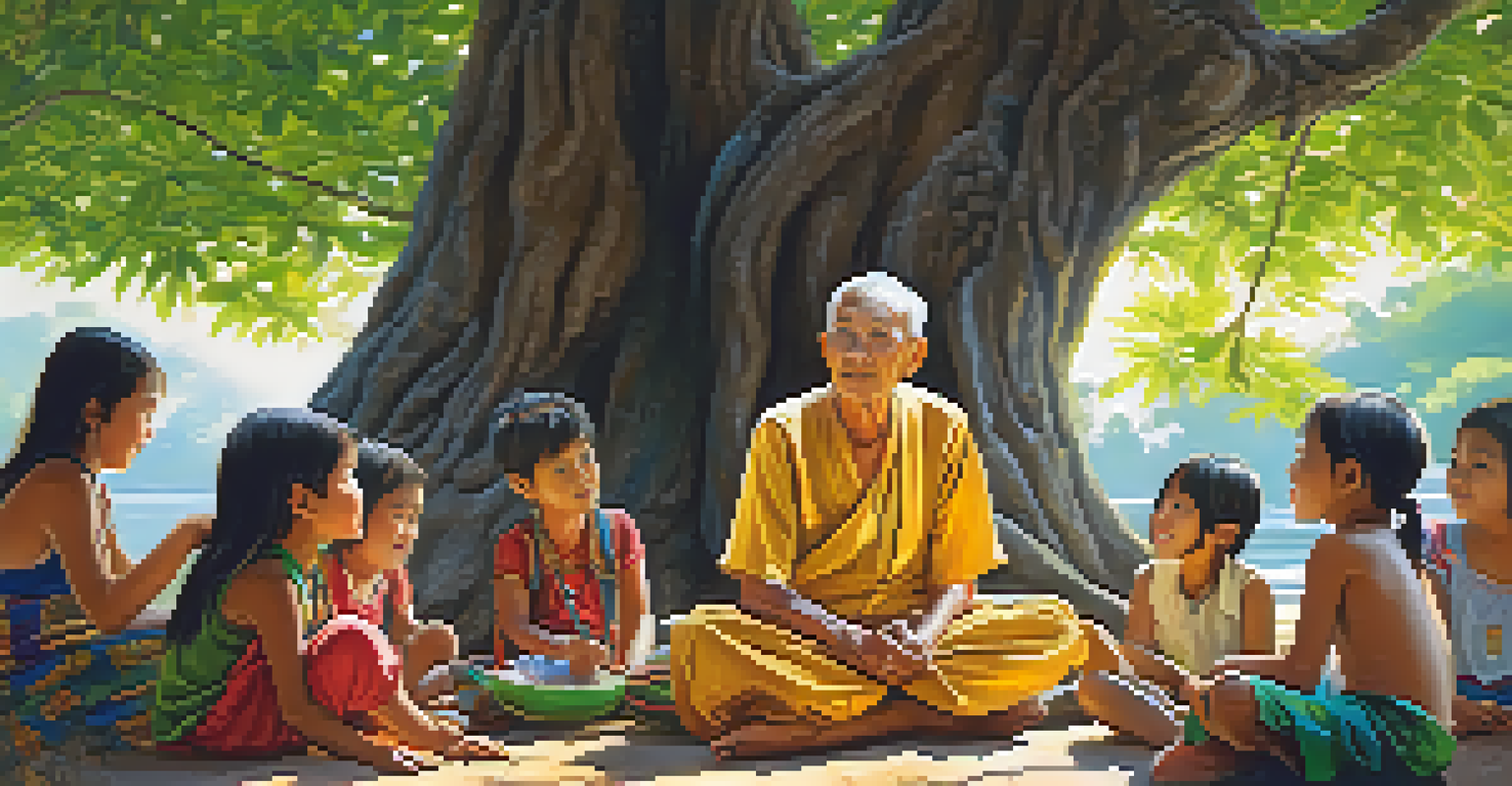The Role of Mythology in Thai Folk Tales and Stories

Understanding Thai Folk Tales Through Mythology
Thai folk tales are rich narratives that reflect the values and beliefs of Thai culture. These stories often intertwine with mythology, making them more than just entertainment; they serve as tools for moral teaching. By examining these tales, we can appreciate how mythology adds depth to the characters and plots.
Stories are the communal currency of humanity.
For instance, tales of mythical creatures like the Naga or Garuda not only captivate listeners but also symbolize various virtues such as loyalty and bravery. This connection to mythology helps to convey essential life lessons that resonate across generations. Ultimately, the blend of folklore and mythology creates a tapestry of stories that enriches Thai cultural identity.
Moreover, these tales often feature gods, spirits, and legendary heroes, showcasing the importance of the spiritual realm in everyday life. By exploring these narratives, one can gain insight into how Thai society perceives morality, justice, and the natural world through a mythological lens.
Common Themes in Thai Mythology and Folk Tales
Many Thai folk tales share recurring themes that are deeply rooted in mythology. One prevalent theme is the struggle between good and evil, often represented by mythical beings. These narratives not only entertain but also emphasize the importance of righteousness and virtue in Thai culture.

Take, for example, the story of Phra Aphai Mani, a heroic figure who battles evil forces. His journey symbolizes the eternal conflict between light and darkness, echoing the moral values upheld by Thai society. Such stories inspire listeners to reflect on their own choices and the consequences that follow.
Mythology Enriches Thai Folk Tales
Thai folk tales intertwine with mythology, providing moral lessons and reflecting the cultural identity of the Thai people.
Additionally, themes of adventure, transformation, and destiny frequently appear in these tales. These elements not only captivate audiences but also illustrate the belief that life is a journey filled with challenges and lessons, mirroring the trials faced by the characters in the stories.
The Influence of Buddhism on Thai Mythology
Buddhism plays a significant role in shaping Thai mythology and, consequently, its folk tales. Many stories incorporate Buddhist teachings, weaving them into the fabric of folklore. This influence is evident in themes such as compassion, mindfulness, and the quest for enlightenment.
Myth is the beginning of all real knowledge.
For instance, tales about the previous lives of the Buddha are often narrated to impart valuable lessons about karma and moral conduct. These stories remind listeners that their actions have consequences, encouraging them to lead virtuous lives. This blend of Buddhist philosophy and mythology enriches the narrative landscape of Thai folk tales.
Moreover, festivals and rituals in Thailand are often influenced by these stories, further illustrating the intertwining of mythology and spirituality. Celebrations such as Songkran and Loy Krathong frequently feature mythical elements, reinforcing the cultural significance of these narratives in everyday life.
The Role of Nature and the Supernatural
In Thai folk tales, nature often plays a critical role, with many stories rooted in the natural landscape. Mountains, rivers, and forests are not just backdrops; they are integral characters that shape the narrative. This connection to nature reflects the Thai belief in the harmony between humans and the environment.
Mythical creatures associated with nature, like the spirit of the forest, are common in these tales. They often serve as guardians, symbolizing the respect and reverence the Thai people have for their surroundings. Through these stories, listeners learn about the importance of preserving nature and living in balance with it.
Buddhism Shapes Moral Narratives
Buddhist teachings are woven into Thai folk tales, emphasizing virtues like compassion and the consequences of actions.
Additionally, the supernatural elements in these tales highlight the belief in spirits and guardians that influence people's lives. This belief fosters a sense of connection to the unseen world, encouraging individuals to respect both the natural and spiritual realms.
The Oral Tradition of Thai Folk Tales
The oral tradition is a vital aspect of Thai folk tales, as stories are passed down through generations. This method of storytelling fosters a communal experience, engaging listeners and allowing them to interact with the narrative. Elders often share these tales, ensuring that cultural values and lessons remain alive.
As these stories are recounted, they often evolve, with each storyteller adding their unique touch. This adaptability allows folk tales to remain relevant, reflecting contemporary issues while staying rooted in tradition. It’s a beautiful example of how culture can grow while retaining its core values.
Moreover, the oral tradition highlights the importance of memory and storytelling in preserving cultural identity. In a world dominated by technology, these narratives remind us of the power of face-to-face communication and the shared human experience.
The Impact of Modernization on Thai Folk Tales
As Thailand moves toward modernization, the landscape of folk tales is also evolving. While traditional stories remain cherished, new interpretations and adaptations are emerging to resonate with contemporary audiences. This shift reflects the changing values and realities of Thai society.
For example, some modern adaptations incorporate urban settings and contemporary issues, making the stories more relatable to younger generations. This fusion of old and new ensures that the essence of the tales is preserved while appealing to a broader audience. It’s a fascinating way to explore how mythology can adapt over time.
Modernization Alters Traditional Stories
As Thailand modernizes, folk tales evolve to resonate with contemporary audiences while striving to preserve their traditional essence.
However, this modernization raises concerns about the preservation of traditional narratives. Balancing innovation with authenticity is crucial to maintaining the cultural heritage that these folk tales represent. Finding ways to honor the past while embracing the future will be key in this ongoing evolution.
The Educational Value of Thai Folk Tales
Thai folk tales serve not only as entertainment but also as powerful educational tools. They often encapsulate moral lessons, cultural values, and historical context, providing listeners with a deeper understanding of their heritage. This educational aspect makes folk tales an essential part of Thai cultural education.
Children, in particular, benefit from these narratives, as they learn about virtues like honesty, respect, and perseverance through engaging stories. The captivating nature of these tales makes learning enjoyable, allowing important life lessons to resonate deeply. It’s a fantastic way to instill values in the younger generation.

Furthermore, educators can use these folk tales to teach about Thai history and traditions, fostering a sense of pride and identity. By integrating mythology into the curriculum, students can appreciate the richness of their cultural background while developing critical thinking skills through storytelling.
Conclusion: The Enduring Legacy of Thai Mythology
The role of mythology in Thai folk tales is a testament to the enduring legacy of cultural narratives. These stories not only entertain but also educate, inspire, and connect people to their roots. They encapsulate the essence of Thai values, beliefs, and identity.
As we explore these tales, we are reminded of the importance of storytelling in preserving culture. The interplay between folklore and mythology enriches our understanding of humanity and the lessons we can learn from the past. It’s a beautiful reminder that stories have the power to shape our lives and communities.
Ultimately, the fusion of myth and folklore in Thai storytelling will continue to thrive, evolving while remaining deeply connected to its origins. This dynamic relationship ensures that the wisdom of the past remains relevant, guiding future generations through the timeless lessons embedded in these captivating narratives.